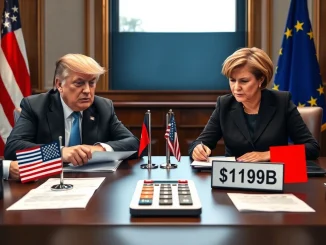
In a move that could significantly reshape transatlantic trade relations, the European Union (EU) is reportedly drawing up a list of concessions aimed at easing tensions with the United States over tariffs. This development, as reported by Bloomberg, comes as the specter of renewed trade disputes looms with former US President Donald Trump potentially returning to the White House. What does this mean for global trade and the delicate balance of international economies? Let’s dive into the details.
Understanding the Looming Threat of US Tariffs
Tariffs, in simple terms, are taxes imposed by a government on imported goods or services. They act as a barrier, making imported products more expensive and thus potentially protecting domestic industries. However, they can also spark retaliatory measures, leading to trade wars that impact consumers and businesses alike. Why are tariffs such a hot topic right now?
- Protectionism: Tariffs are often used as a tool to protect domestic industries from foreign competition.
- Revenue Generation: Governments can collect revenue from tariffs, although this is often a secondary goal.
- Negotiating Leverage: The threat of tariffs can be used as leverage in international trade negotiations.
- Economic Impact: Tariffs can raise prices for consumers, reduce exports, and disrupt global supply chains.
The current situation stems from previous trade disputes initiated during Donald Trump’s presidency, where the US imposed tariffs on goods from various countries, including the EU. Now, with the possibility of Trump returning to power, the EU is proactively seeking to de-escalate potential conflicts.
The Complex Relationship of EU and US Trade
The EU and the US are two of the world’s largest economies and have a deeply intertwined trade relationship. This partnership is built on decades of cooperation and mutual benefit, but it has also faced periods of strain. Understanding this relationship is crucial to grasping the significance of the current tariff talks.
| Aspect | EU | US |
|---|---|---|
| Economy Size (GDP) | Approximately $18 trillion | Approximately $25 trillion |
| Major Industries | Automotive, Aerospace, Pharmaceuticals, Chemicals, Machinery | Technology, Finance, Healthcare, Retail, Manufacturing |
| Trade Volume (EU-US) | Billions of dollars annually | Billions of dollars annually |
| Key Trade Areas | Goods, Services, Digital Trade | Goods, Services, Digital Trade |
Despite the economic strength and interconnectedness, trade disputes have arisen, particularly concerning agricultural products, aircraft manufacturing, and more recently, digital services and technology. These disputes highlight the delicate balance that needs to be maintained in this crucial economic partnership.
Trump’s Trade Policies: A Quick Recap and Potential Return
During his first term, Donald Trump pursued an “America First” trade policy, characterized by aggressive use of tariffs and a focus on bilateral trade deals. This approach led to trade tensions with numerous countries, including the EU. Key aspects of Trump’s trade policies included:
- Steel and Aluminum Tariffs: Imposition of tariffs on steel and aluminum imports, citing national security concerns.
- Trade War with China: Extensive tariffs on Chinese goods, leading to a tit-for-tat trade war.
- Threats to Withdraw from WTO: Criticism of the World Trade Organization and threats to withdraw from it.
- Renegotiation of NAFTA: Renegotiation of the North American Free Trade Agreement, resulting in the USMCA.
The prospect of Trump returning to office has reignited concerns about a resurgence of these protectionist policies. The EU is now proactively trying to engage in trade talks to mitigate potential damage from renewed US trade aggression.
EU’s Strategic Concessions for Trade Talks: What’s on the Table?
The EU preparing a list of concessions for trade talks signals a strategic shift towards proactive diplomacy. While the exact details of these concessions remain confidential, they are likely to address areas of previous contention and potential future disputes. What kind of concessions might the EU be considering?
- Agricultural Products: Potentially offering to increase quotas or reduce tariffs on certain US agricultural exports to the EU.
- Industrial Goods: Exploring ways to address US concerns about market access for industrial goods in the EU.
- Regulatory Cooperation: Seeking to enhance regulatory cooperation to reduce trade barriers related to standards and certifications.
- Digital Economy: Engaging in discussions on digital trade and data flows to find common ground and avoid future disputes in this rapidly evolving sector.
These potential concessions are not simply about giving in; they are about strategically navigating a complex geopolitical landscape and safeguarding the long-term interests of the EU economy. The goal is to create a stable and predictable US trade environment, even amidst political uncertainty.
Implications for the Global Economy and Beyond
The outcome of these trade talks between the EU and the US will have far-reaching implications for the global economy. A successful negotiation that avoids escalating tariffs could:
- Stabilize Global Trade: Reduce uncertainty and promote smoother international trade flows.
- Boost Economic Growth: Support economic growth in both the EU and the US by reducing trade barriers.
- Strengthen Transatlantic Relations: Improve political and economic relations between the EU and the US.
- Set a Positive Example: Demonstrate the value of dialogue and negotiation in resolving trade disputes, setting a positive precedent for other nations.
Conversely, a failure to reach an agreement and a resurgence of tariffs could lead to:
- Trade Wars: Escalating trade tensions and retaliatory tariffs, harming businesses and consumers.
- Economic Slowdown: Negative impact on global economic growth due to trade disruptions and increased costs.
- Geopolitical Instability: Strain on international relations and increased geopolitical uncertainty.
Conclusion: A Critical Juncture for Global Trade
The EU‘s proactive approach to preparing concessions for US tariff talks represents a critical moment for global trade. As the world watches closely, the outcome of these discussions will not only shape the future of EU-US trade relations but also send a powerful signal about the direction of international economic cooperation in an increasingly uncertain world. Whether these trade talks lead to a breakthrough or a breakdown remains to be seen, but one thing is clear: the stakes are incredibly high, and the world’s economic future hangs in the balance.



